To the delight of Calgary Flames fans, the fab four of Andrew Mangiapane, Johnny Gaudreau, Oliver Kylington and Matthew Tkachuk are off to sizzling starts through the first quarter of the season. Their stellar play puts them in line for hefty pay increases at the expiration of their contracts next summer and therein lies the seeds of a major salary cap problem that could force Flames general manager Brad Treliving into some hard decisions.
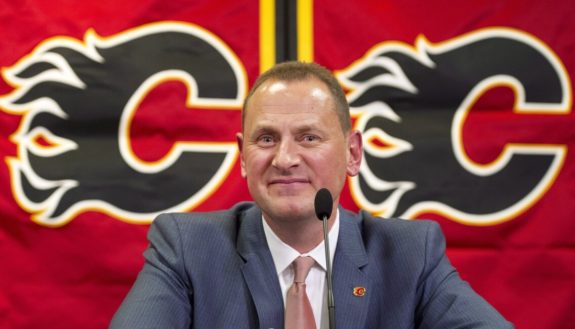
The NHL’s salary cap this season is $81.5 million per team, and while available cap space fluctuates for different reasons, as of writing, the Flames have spent almost to the limit on their current roster. They may have $2.5 million more in additional space next season with the $1.5 million in dead cap space devoted to buying out Troy Brouwer coming free and a rumoured $1 million increase in the cap limit.
Even so, much of that additional cap space would be eaten up quickly by the big increases that the fab four will deserve and surely demand if they keep up their collective performance. That will make it hard for Treliving to afford new talent and could force him into dumping salary. What’s more, it may prod him to conclude deals with some or all of the four prior to the NHL trade deadline on March 21.
Projecting the Flames’ 2022-23 Salary Cap Situation
There are currently 12 players with contracts that extend past the end of the 2021-22 season. The Flames budget $51.3 million in total to cover these commitments. They spent another $12.3 million on nine depth players under one-year contracts to round out their roster. Leaving out the dead Brouwer cap space and adding in the current combined cap hit of the fab four, the Flames’ tab for talent hits $80.5 million. That’s just $2 million under next year’s expected salary cap of $82.5 million, but doesn’t consider how much more money it will take to re-sign the fab four.
You may also like:
- Roadrunners Can’t Beat Dustin Wolf, Lose Game 1
- Prime Video to Carry National Monday Night Games in Canada
- Grading Every Flames Player’s Performance in 2023-24
- NHL Rumors: Oilers, Flames, Maple Leafs, Flyers
- Flames’ Kadri Exceeded Expectations in 2023-24
It’s obvious there won’t be much wriggle room to get under the cap next season, leaving Flames fans wondering how much money will be available to sign new talent. The short answer — depending on the assumptions made — is very little, if anything. It all depends on the money it takes to re-sign those four.
Mangiapane Contract Renewal
The 5-foot-10, 184-pound dynamo can’t stop scoring. With 15 goals to this point in the season, he’s tied for second place in goals alongside the New York Rangers’ Chris Kreider and the Washington Capitals’ Alexander Ovechkin and has scored one more goal than the Edmonton Oilers’ Connor McDavid.
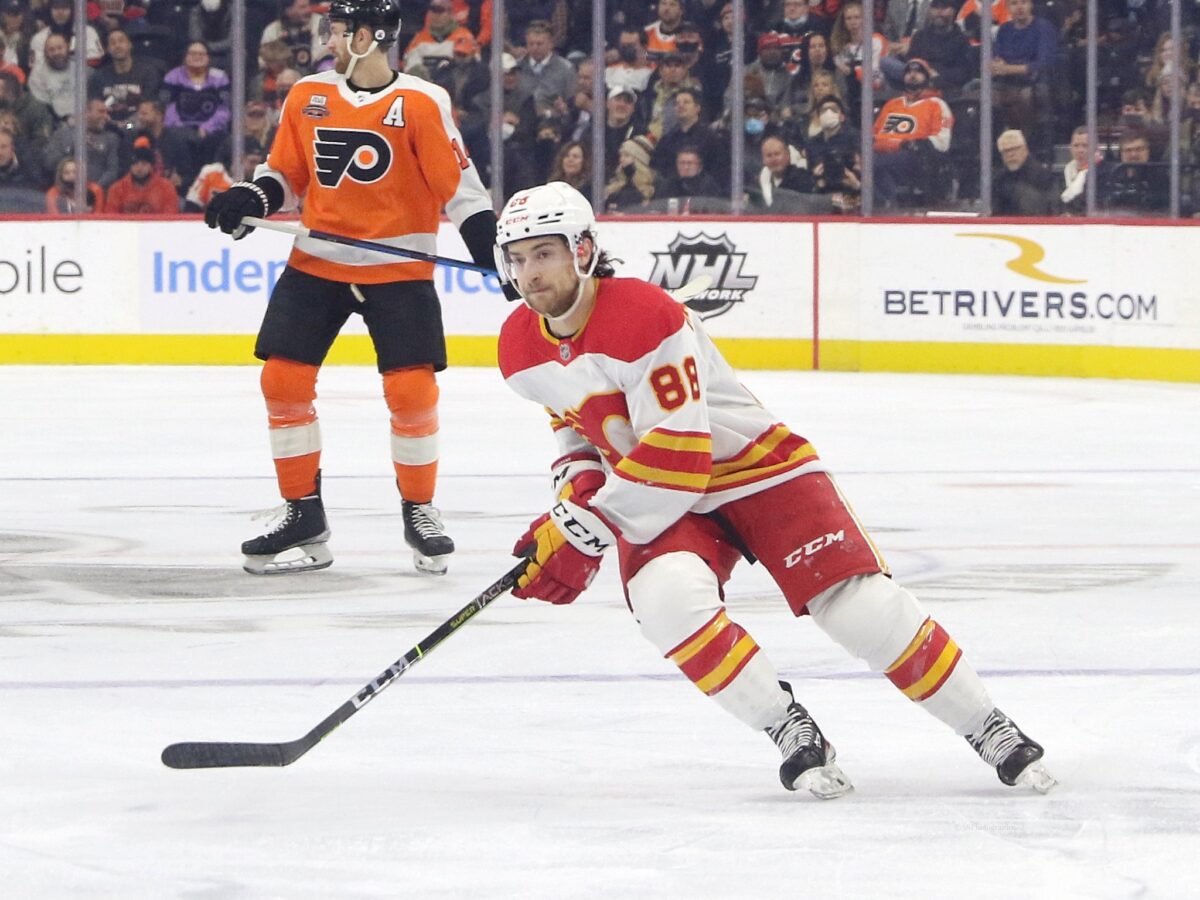
On total points scored, he can’t be compared to Ovechkin and McDavid. Yet with 17 points, he is now in the company of Mitch Marner, William Nylander and Auston Matthews of the Toronto Maple Leafs and David Pastrnak of the Boston Bruins, to name a few of his new-found peers.
It’s early in the campaign and Mangiapane’s incredible goal production is sure to cool off. There will inevitably be a slump or two over the remaining 62 games in the season. Even so, he is likely to score 30 goals, if not more.
While the Flames may have been able to sign him at the end of last season to a three- or four-year deal in the range of $4.5 million per, that figure isn’t close to what many pundits think he could now command after his performance with Team Canada in the World Hockey Championship last summer and his red-hot goal production so far this season.
Mangiapane is a tough negotiator and almost took the Flames to arbitration before signing his current deal in October 2020. When he becomes a restricted free agent (RFA) in July, he has the same option and that’s a situation the Flames will want to avoid. Better to negotiate something reasonable with the young star soon rather than leave his salary to the vagaries of arbitration — something that could result in a higher salary than the Flames could have negotiated. Not only that, but going through the complete arbitration process in the case of RFAs results in a one-year contract being awarded. That means Mangiapane could walk straight into unrestricted free agency (UFA) and right out of Cowtown in one year.
Taking out some salary outliers such as Mangiapane himself, players now in the top 10 scoring list earn between $6.4 (Alex DeBrincat of the Chicago Blackhawks) and $9.5 million (Ovechkin). If Mangiapane is the real deal and can finish the season among the top 10 scorers, then I would argue he’s in the company of Kreider ($6.5 million cap hit) and the Winnipeg Jets’ Kyle Connor ($7.14 million).
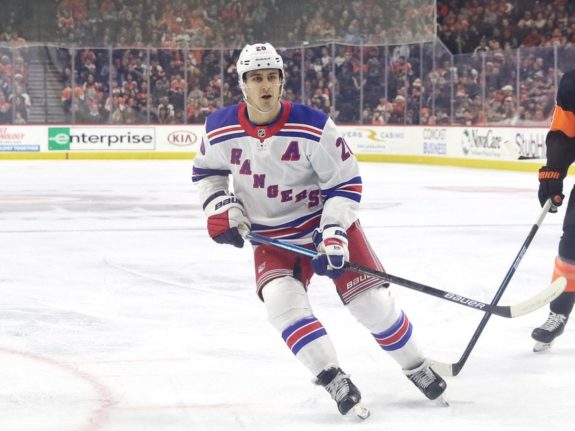
From a points perspective, if Mangiapane continues his current production, he would finish the season with at least 50 points. In last year’s COVID-19 shortened season that would have translated into roughly 35 points, meaning that his equals would have included not only Kreider, but players such as the Bruins’ Taylor Hall (cap hit of $6 million), the Philadelphia Flyers’ Cam Atkinson ($5.88), and the Carolina Hurricanes’ Nino Niederreiter ($5.25 million).
Perhaps Mangiapane’s strongest argument for a big salary increase, assuming he maintains his current level of play, will be what the Flames are paying several of his teammates. As one pundit commented after a recent episode of the Flames Faceoff on The Hockey Writers’ podcast network, “If I’m Mangiapane and I see Blake Coleman making $4.9 million, I’m not asking a penny less than $5.9 million.” What’s more, assuming he notches 30 goals and 50 points this season, it’s hard to argue he is worth less than Gaudreau who will earn $6.75 million this year.
With all this in mind, I believe the Flames would need to offer Mangiapane a four- to five-year deal. I predict the following salary range:
Low: $6.0 million
High: $7.0 million
Projecting Tkachuk’s New Contract
Tkachuk will become an RFA next summer. If the Flames want to retain his rights, they must offer a one-year, $9 million qualifying offer (QO) under the league’s Collective Bargaining Agreement.
Negotiations will be tough because the Flames are dealing with a member of the notoriously hard-nosed Tkachuk family. His father Keith sat out after his contract talks stalled with the Phoenix Coyotes in 1998, and his brother Brady missed training camp this season with the Ottawa Senators as his negotiations on a new contract dragged on.
Tkachuk holds all the cards in these negotiations. As with Mangiapane, he could walk out the door as an unrestricted free agent (UFA) in just one year after signing a QO. If the Flames can’t sign him before the trade deadline, then it’s better to trade him while they still have him under contract for the better part of two seasons. At least then they would get something for him in a trade.
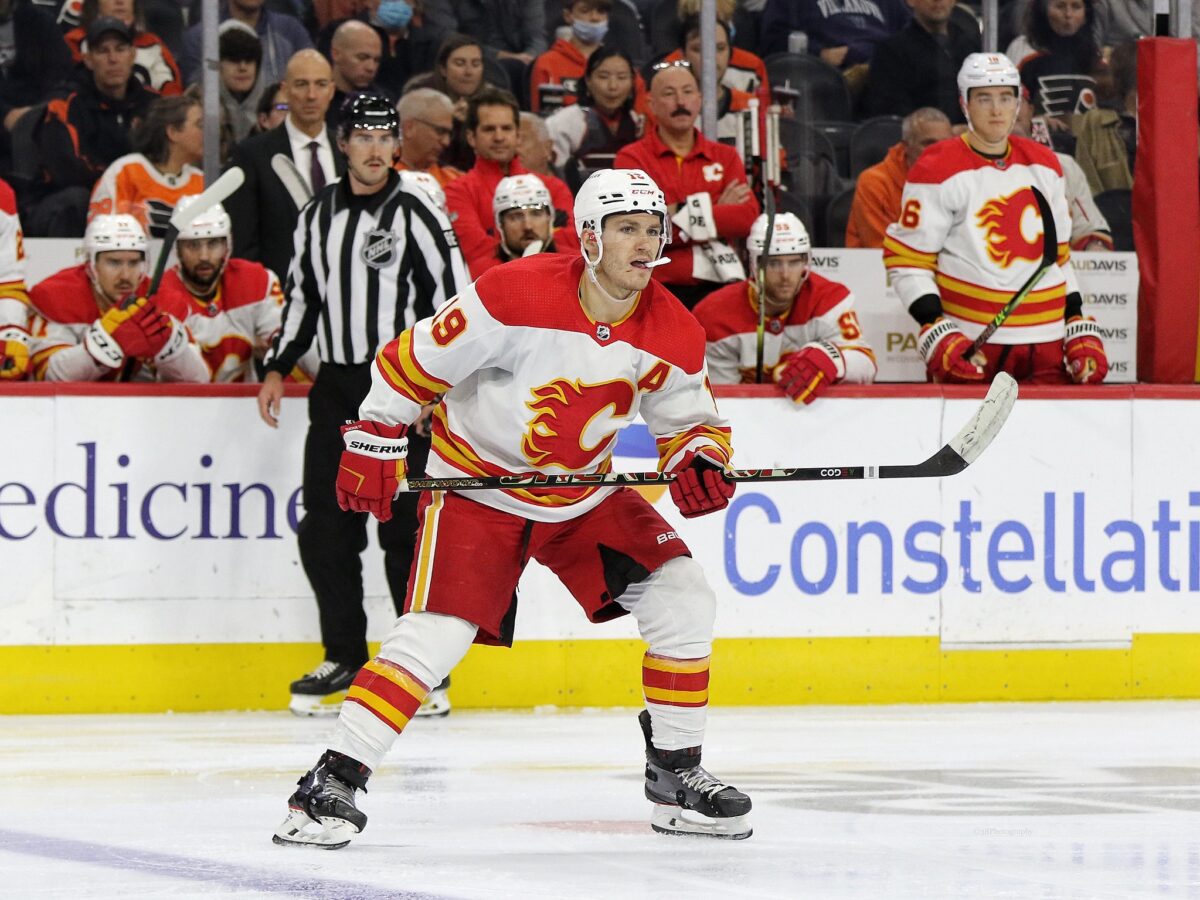
At a cap hit of $9 million, Tkachuk would be comparable to the Buffalo Sabres’ Jeff Skinner, and the New Jersey Devils’ P.K. Subban and Dougie Hamilton. If he pushes for more, as he surely will, then he’s in the company of the Vegas Golden Knights’ Mark Stone, Ovechkin, the Tampa Bay Lightning’s Nikita Kucherov and Jamie Benn of the Dallas Stars who all earn $9.5 million per season. An ask of $10 million says he thinks he’s the equal of Jack Eichel of the Golden Knights and Anze Kopitar of the Los Angeles Kings.
Making direct comparisons between Tkachuk and such a select group is difficult. While he’s not a pure finesse player, Tkachuk possesses a complete game and is able to put points on the board (albeit not at an elite level), bang and crash in front of the net and fire up his team mates. He is a heart-and-soul player and likely the team’s next captain. With 18 points currently on the season, he sits at 14th in the league in a crowded group of players that includes Kopitar, the Maple Leafs’ John Tavares ($11 million cap hit) and Kirill Kaprizov of the Minnesota Wild ($9 million).
Related: Flames Slow Start Could Lead to Gaudreau, Monahan and Tkachuk Trades
Assuming Tkachuk remains among the top three on Calgary’s points chart, management will do what it takes to re-sign him to a long-term deal. That’s a must if he is to wear the “C” on his sweater. I predict his salary range will be:
Low: $9.5 million
High: $10.5 million
Gaudreau’s Contract Renewal
Gaudreau seems to have found his mojo from his shimmering 99-point 2018-19 season and sits sixth in the league in total points notched. If he stays in the top 10, he’ll likely want a six-year contract extension, but by then he will be 29 years old with his best scoring years behind him.
That’s why Treliving would probably prefer a two- to three-year extension at most. However, the term should be easier to overcome than salary. Gaudreau will realize that a long-term deal with the Flames will be his last chance to earn big dollars. He will be pushing for a significant salary increase.
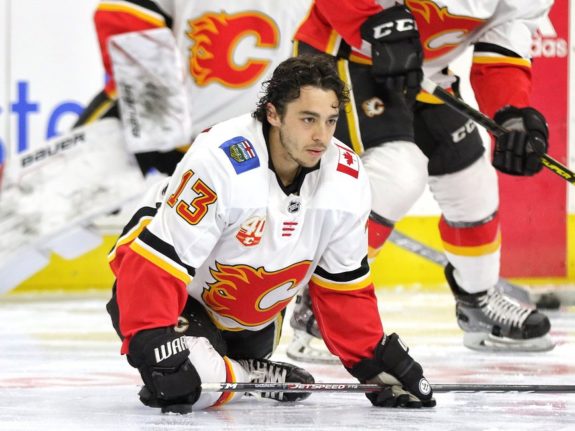
The Flames’ time is now and they should be able to remain Cup contenders for the next few seasons. They’ll need Gaudreau going forward. Even so, he will be an unrestricted free agent (UFA) when his contract expires this summer, and the Flames can’t let him walk out the door for nothing. That puts pressure on the organization to re-sign him before the trade deadline.
If Treliving feels the odds of re-signing him are good, then it makes no sense to put him on the trade block. Making the prospect of a trade even less palatable is the modified no-trade clause (MNTC) in his contract that limits a trade to just five teams. That makes it more unlikely the Flames would fetch a better player coming back the other way.
In the 2018-19 season, the last uninterrupted season the NHL played before the COVID-19 pandemic, Gaudreau ended the season tied for fifth overall in total points alongside the Colorado Avalanche’s Nathan MacKinnon ($6.3 million cap hit), one point ahead of Steve Stamkos of the Lightning ($8.5 million) and just a point behind the Bruins’ Brad Marchand ($6.1 million).
This season, sitting at seventh in points, comparable salaries range from the Avalanche’s Nazem Kadri’s $4.5 million to the Capitals’ Evgeny Kuznetsov’s $7.8 million. Connor sits in the middle at $7.1 million. It’s likely that Gaudreau’s next contract will be in the two to three-year range given his age. I predict the following salary range:
Low: $7.7 million
High: $8.0 million
Kylington’s Next Contract
Kylington becomes an RFA in July when his current one-year contract, carrying a cap hit of $750,000, expires. His 12 points so far this season puts him at fifth on the Flames’ points board — the most of any Flames defenceman despite logging modest ice time. In his first 12 games, he was producing a point per game — all at even strength. His plus/minus is plus-10.
His performance to date is on par with an elite group of defencemen that includes Alex Pietrangelo of the St. Louis Blues, the Sabres’ Rasmus Dahlin, Kris Letang of the Pittsburgh Penguins and Darnell Nurse of the Oilers. Even so, nobody is going to argue he should be considered in this exclusive club of D-men based on what he has shown thus far in his career.
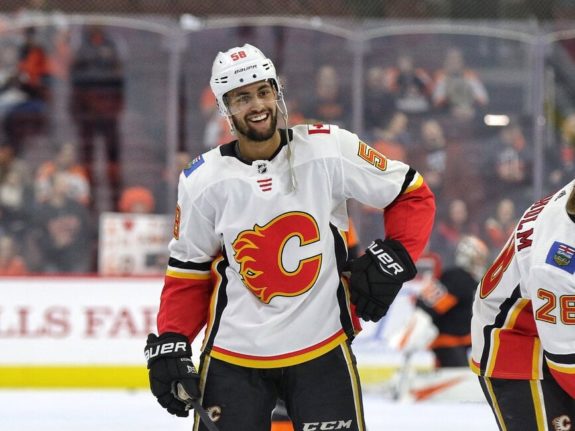
It looks like this is the young Swedish defenceman’s breakout season after bouncing back and forth between the Stockton Heat and the big club in Calgary over the last six seasons. Even so, it will be difficult for the Flames to assign a dollar value to Kylington based on just one good season in the league. He needs to demonstrate more for longer.
Related: Flames’ Kylington Has Earned Top Four Spot
For that reason, I predict Kylington will be offered a two- to three-year bridge deal. As for salary, players who log 30-40 points in a season generally find themselves in the $2 million salary range. If Kylington can keep up his performance and registers north of 30 points, I predict his salary as follows:
Low: $2.0 million
High: $2.5 million
The Flames Success Will Come at a Price
To recap, leaving aside the fab four’s current contracts and barring personnel changes, the Flames can expect to be spending $63.6 million on salaries at the end of the season. Assuming the salary cap increases to $82.5 million that leaves $18.6 million to secure new contracts with the four.
With the Flames paying each of the four at the high end of the salary ranges noted above, they would be roughly $9 million over next year’s expected cap. If the four all signed at the low end of the estimates they would still be $6.3 million over.
There are more than a few ways the Flames could deal with this including select salary dumps (think an underperforming Sean Monahan at $6.4 million per year) and for depth, bringing up low-cost players from Stockton instead of hiring more costly journeymen such as Nikita Zadorov, Erik Gudbranson and Tyler Pitlick. Still, it will be difficult for Treliving to tuck all four under the cap next year. Adding additional high-end talent will be well-nigh impossible.